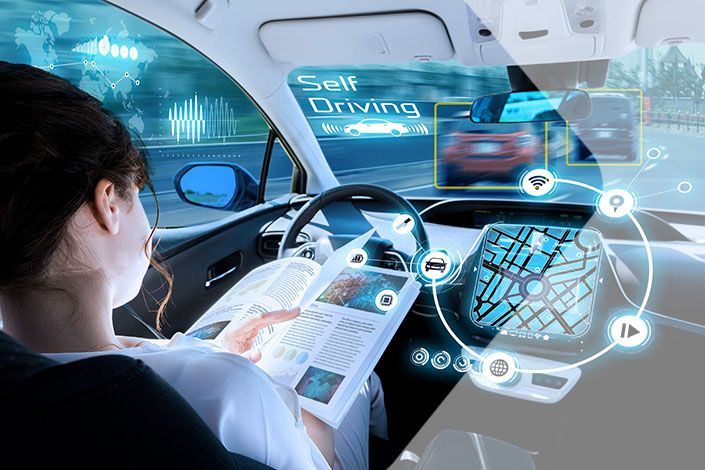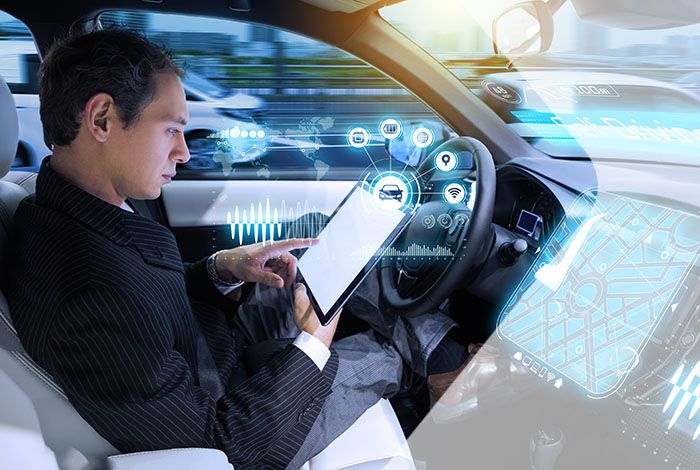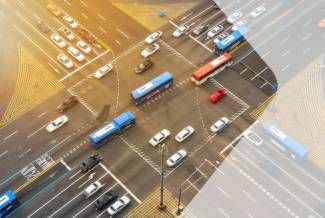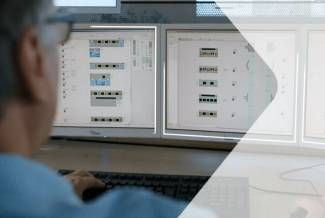Autonomous driving: Safety & IT Security
Autonomous driving should make driving more comfortable and safer in the future. With the help of technical means such as AI, sensors and cameras, vehicles will be able to navigate independently through traffic. For this purpose, vehicles have various sensors installed so that they can be steered safely. In addition, the vehicles use artificial intelligence to analyse and evaluate traffic and to behave cooperatively.
On this page you will get clear answers and learn everything about the safety aspects of fully automated driving.
How safe is autonomous driving?
One of the major challenges of autonomous driving are the safety aspects. Can an autonomous vehicle really perceive and interpret the environment reliably in order to navigate safely?
At least as far as functional safety for autonomous driving is concerned, the situation is quite clear: information is sent to the vehicle via the technical equipment – e.g. LiDAR and camera systems, AI and sensors in the optical and microwave range. This multitude of data has to be bundled and evaluated by sophisticated fusion of the systems. But how reliable are all these sensors and cameras?
Good to know: Autonomous vehicles not only use laser sensors to register the vehicle's surroundings within a radius of several hundred metres, but also a whole range of different camera types, including stereo, wide-angle and telephoto cameras.
The state of the art is mainly oriented towards imaging techniques and looks as follows with regard to safety in autonomous driving:
Radar sensors
Radars register reflective objects and help the vehicle to orientate itself over relatively long distances. They function without problems even in darkness, fog, snow, smoke or dust. However, depth perception, object extension and angular position are problematic. This means that they only detect part of the road, which can lead to inconclusive navigation.
Solution: Radar systems are placed at a certain distance on the bonnet to create an overlapping field of view. This creates a high-resolution image that is highly likely to register all obstacles.
LiDAR systems
Scanning LiDAR systems provide high-resolution 3D images of the environment, but are highly sensitive to bad weather such as fog, rain or snow. They measure distance and angular positions accurately even with multiple objects, but the detection distance is much smaller than with radar. In addition, LiDAR systems are still expensive.
Good to know: At Auto Shanghai 2023, 38 models were already equipped with LiDAR. Volvo, Tesla and Mercedes-Benz also want to rely on LiDAR in the future.
Camera-based systems
Camera systems can register current speed limits, no-overtaking or no-driving signs at a distance of up to 80 metres. They have various functions, e.g.:
- Colour and grey image evaluation
- Filter operations
- edge and feature extraction,
with which the incoming data can be evaluated. Some systems also evaluate, for example, via comparisons or deep learning algorithms. In this way, they recognise traffic signs, objects in road traffic (e.g. bicycles, lost loads on motorways, animals and pedestrians) or roadside verges.
Learn more: Road marking visibility for machine vision
Good to know: With a lot of computing effort and good lighting, stereo cameras are able to calculate depth information from a pair of images and thus allow spatial vision. Less expensive mono cameras can only estimate the surroundings or distances and must first "get to know" objects.
PMD Technology
PMD technology (Photonic Mixer Device) is based on optical sensors that use time-of-flight techniques to calculate the direct distance to objects and generate a 3D image. PMD is therefore promising because the sensors actively suppress extraneous light and are therefore insensitive to non-correlated light signals. Disadvantages: A clear determination of distance is not always possible. In addition, the range is still very limited.
Ultrasound & Infrared
The low-cost ultrasonic systems are already known from parking sensors and are considered mature. These reliably estimate short distances even in bad weather and are standard equipment at BMW, for example. According to automotive supplier Valeo, ultrasound is important for Adaptive Cruise Control, Stop&Go or Blind Spot Detection. Infrared sensors remain just as important for reliably registering objects even when driving at night.
Good to know: Driver state detection is also indispensable for safety. In 2021 alone, Statista recorded over 1,500 accidents with personal injury in Germany that were due to fatigue. In addition, according to a study by infas quo, every 10th accident is caused by distraction.
Therefore, warning systems in numerous vehicle models react to factors and signals such as:
- Rigid steering wheel posture
- High steering wheel deflection
- Time of day and driving duration
- Longitudinal and lateral acceleration
Driver monitoring is also becoming increasingly important. This registers, for example, the driver's eyelid closing behaviour and direction of gaze.
But does this guarantee safety for autonomous driving? Since none of the sensor systems mentioned can cover all the necessary factors, developers of autonomous vehicles rely on a combination of different sensors. So far, however, it is not yet possible to completely dispense with the perceptive power of humans.
Learn more: Autonomous driving
Concrete solutions by SWARCO
Autonomous vehicles: advantages for road safety
Safety for autonomous driving is a highly debated topic. Thus, autonomous driving cars show great potentials, but also various challenges. Interestingly, according to infas quo, more than one in three German drivers fear higher distraction from built-in driving assistants and therefore lower road safety. Nevertheless, autonomous driving has the potential to significantly improve road safety.
Here are some reasons why:
1. No human error
Autonomous vehicles are equipped with advanced technology that enables them to handle a variety of driving situations. Once they are fully matured, they are very likely to act more reliably than human drivers who make mistakes due to overtiredness, drunkenness or distraction by cell phones.
2. Faster reaction time
Thanks to their sensors and algorithms, autonomous vehicles can recognize other road users and, in some cases, react faster than human drivers to unforeseen events. This could also prevent accidents.
3. Accurate decisions
Unlike human drivers, who can make incorrect decisions under stress or in panic, autonomous vehicles are based on precise data and logic. However, in order to fully rely on this, the technology must first be mature.
4. Compliance with traffic rules
Autonomous vehicles strictly adhere to speed limits and other traffic rules. This reduces the risk of accidents due to speeding or other rule violations.
5. Communication between cars
Connected autonomous vehicles can communicate with each other and exchange information to make traffic safer. For example, an autonomous car in a construction zone can send a warning message to other autonomous cars so that they reduce their speed in time.
6. Improvement of the infrastructure
Autonomous driving could also help improve the infrastructure of the road network, as autonomous cars can communicate with the infrastructure to avoid congestion or bottlenecks. Overall, autonomous driving can help to significantly improve road safety and reduce the risk of accidents.
7. Enhanced safety measures
Autonomous vehicles are equipped with advanced safety features - including automatic braking, lane departure warning and evasive maneuvers - to prevent accidents or minimize their impact.
8. More efficient rescue operations
If an autonomous vehicle is involved in an accident, it can be located more easily than a conventional car. This enables a faster and more effective rescue of the occupants.
Overall, all these factors indicate that road safety can be increased via autonomous driving and that autonomous vehicles can even help to reduce the number of road accidents.
Good to know: GPS alone is too inaccurate to detect and transmit locations of a self-driving car. A combination of GPS & measurement technology, high-resolution maps and sophisticated systems is essential.

IT security risks for autonomous driving
Questions arise not only in road traffic, but also in individual vehicle security: How secure is an autonomous vehicle against hacker attacks? After all, a car that has software and is constantly online can theoretically also be hacked like a PC or smartphone. Attack surfaces are, for example:
- Radio systems (tire pressure monitoring, Bluetooth, etc.):
- SD card reader
- Maintenance via USB and diagnostic interfaces
- SIM cards
- Keyless systems
- Infotainment systems
- NFC (open door via cell phone)
- RFID card
- Assistance systems
- Cloud technology
There is a possibility that hackers could remotely attack the vehicle via wireless systems such as Bluetooth or tire pressure monitoring. Vehicles could be hijacked and released via ransom. There are also risks associated with maintenance: malware can enter the system via a USB stick, for example.
Further risks exist with:
- Vehicle to Vehicle (V2V)
- Vehicle to Infrastructure (V2I)
- Personal data
- OBD-II (Vehicle Diagnostic System)
- Spam
Not only could hackers obtain stored personal data in the car (such as: playlists or appointments), but also the data of the automobile itself could be compromised to gain advantages. For example, there is a possibility that statistics on mileage could be faked to trick future buyers or insurance companies.
Spam that pops up on the screen at the unwanted moment can also be a distraction and thus a danger. Thus, there is a wide range of potential risks that need to be considered. So far, however, hacker attacks have only been simulated in order to find weak points and improve the security system. Researchers are intensively engaged in developing secure software and eliminating vulnerabilities.

Measures to improve IT security for autonomous driving.
In the future, autonomous vehicles will be networked with the infrastructure and communicate via a dense network. In this context, it is essential that data is well encrypted. Communication with onboard sensors and the infotainment system must also be encrypted.
Car manufacturers must therefore take care to install a sophisticated intrusion detection system (IDS) in cars to protect vehicles against possible attacks. "Secure by design" is therefore the motto by which cybersecurity solutions should already be incorporated into the development of autonomous vehicles. In this way, security for autonomous driving can be guaranteed, privacy better protected, and potential risks within the data exchange chain more visible.
What can be done concretely for in-vehicle systems is:
- Keep the number of external communication interfaces to a minimum.
- Secure interfaces – e.g., via encrypted algorithms or firewalls.
- Install endangered functions and interfaces separately and thus encapsulate them from external interfaces.
Ensuring watertight IT security of autonomous vehicles, however, requires not only manufacturers to work on it, but to collaborate with technology service providers, data scientists and analysts, AI developers, communication technology experts and ML modelers.
Good to know: Increasing connectivity and AI are making cars smarter and smarter. As a result, cyber security regulations in the EU are becoming increasingly stringent. IT security for autonomous driving will therefore probably be given even higher priority in the future.
Other topics related to autonomous driving
Under the links you will find detailed information on the following specific topics:
Autonomous driving: Road safety
It is clear that autonomous driving offers promising technologies that have the potential to increase road safety. Through the use of advanced sensors and algorithms, autonomous vehicles can respond to potential hazards more quickly than human drivers. However, there are still some challenges to overcome before autonomous vehicles can be widely deployed.
Last but not least: Despite the still immature technologies - especially in the IT sector - it is evident that autonomous driving offers great advantages. Even if there are unresolved legal and ethical issues and the infrastructure for autonomous vehicles also needs to be improved, autonomous driving remains a promising future technology with great potential for greater road safety.
FAQ
In principle, autonomous driving can make traffic safer due to the highly developed technology. However, autonomous vehicles are equipped with communication and computer systems that may well be the target of hacker attacks.
Most problems still exist with the camera and sensor technology. These already work well, but some of them have weak points - e.g. in terms of distance or weather conditions such as fog or heavy rain.
Autonomous vehicles have systems that detect hazards or driver incapacity and then bring the vehicle to a halt independently. In the future, this will also be the response in the event of external influences such as hacker attacks. Therefore, autonomous driving is not dangerous.
Since autonomous vehicles are linked to traffic systems, they will be able to avoid traffic jams in the future and thus reduce stop-and-go (keyword: green wave). Long searches for parking spaces will also be a thing of the past. Autonomous vehicles are better for the environment for these and other reasons.

STAY INFORMED
GET OUR NEWSLETTER!
Subscribe to our ITS / Smart Mobility Newsletter and receive regular updates on trends, developments, solutions and events.





